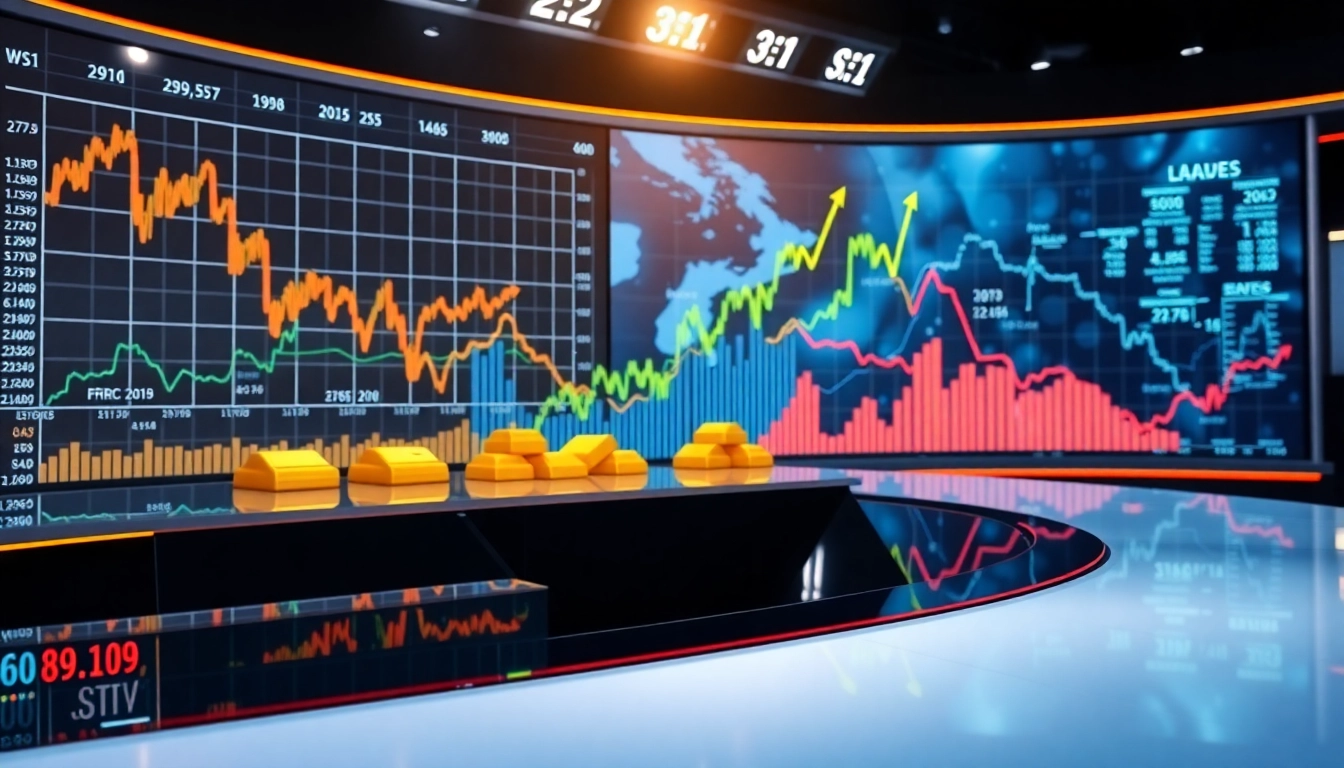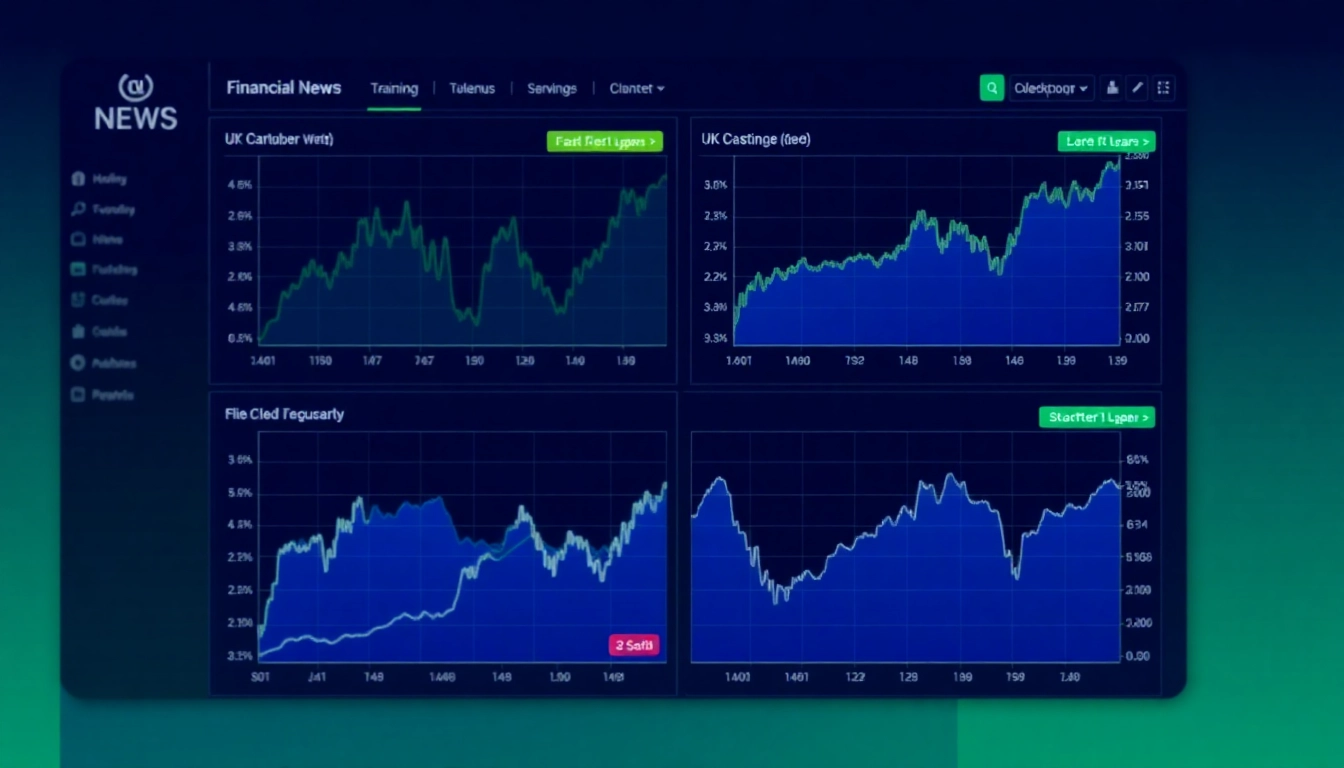
Analyzing Current Investment News Trends
The financial landscape continues to evolve rapidly, driven by a complex interplay of economic data, geopolitical events, and technological advancements. Recently, stock markets have exhibited a mixed performance across global indices, while precious metals like gold have soared to new record highs, capturing investor attention. Currency movements further complicate the picture, affecting investment strategies and portfolio management. As part of staying informed, investors must interpret these events within a broader context, leveraging the latest Investment News for actionable insights. Understanding the causes behind these fluctuations is essential for making informed decisions that adapt to the dynamic market environment.
Global Stock Market Fluctuations and Their Causes
Across Europe, the pan-European STOXX 600 index closed marginally higher, up by 0.17% at 551.07, supported primarily by defense stocks amid geopolitical tensions. Conversely, U.S. markets experienced a downturn, with the Dow Jones and S&P 500 indices declining due to concerns over inflation and monetary policy adjustments. Asian equities followed suit, with the Nikkei reaching a record high fueled by strong corporate earnings and optimistic tech sector outlooks.
These fluctuations are driven by several factors, including macroeconomic indicators, central bank policies, and geopolitical developments. For instance, market volatility increased in response to comments from US Federal Reserve officials hinting at possible rate cuts, which affected currency and equity markets worldwide. Additionally, concerns over US-China trade tensions and tariffs continue to influence global investor sentiment, often resulting in risk-off behaviors that drive safe-haven assets like gold higher.
Emerging markets, while still volatile, have shown resilience amid global uncertainty, sometimes outpacing developed economies. Strategies such as sector rotation and tactical asset allocation remain crucial to navigate these unpredictable fluctuations effectively.
Gold Price Surges and Its Significance for Investors
Gold has recently broken previous records, soaring past $3,500 per ounce—a milestone that highlights its enduring appeal amid market turbulence. Such a rally signifies increased investor demand for safe-haven assets, especially as concerns of inflation persist and geopolitical tensions escalate. The surge is not merely a reflection of market uncertainty but also a hedge against currency devaluations and potential monetary policy shifts.
Investors should interpret gold’s rise as a signal to review their hedging strategies. For example, adding gold ETFs or physical holdings can help diversify risk. Furthermore, analyzing the technical charts reveals that gold prices are supported by buying interest at key Fibonacci retracement levels, indicating potential for continued upward momentum if macroeconomic risks persist.
Historically, gold acts as a counter-cyclical asset, often gaining during periods of inflation or economic distress. Its current record high underscores the importance of incorporating precious metals into diversified portfolios to mitigate volatilities and preserve capital.
Currency Movements and Their Impact on Investment Strategies
Currency markets have exhibited notable shifts, with the US dollar dropping slightly against major currencies such as the yen and euro, while the Australian dollar gained strength. The dollar’s decline coincides with market expectations for potential rate cuts by the Federal Reserve, driven by weaker-than-expected labor data and inflation signals.
For investors, these currency fluctuations influence international investment returns and hedging costs. A weaker dollar benefits U.S. exporters and multinational firms, potentially boosting stock performance in certain sectors. Conversely, currencies like the euro and yen strengthening can signal a risk-on environment, encouraging investment in equities and emerging markets.
Strategic currency hedging becomes essential in this context. Techniques such as forward contracts and options help mitigate adverse impacts, while asset allocation adjustments—like increasing foreign equities—can capitalize on favorable currency trends. Keeping a close eye on economic releases, central bank statements, and geopolitical developments is vital for managing currency risk effectively.
Analyzing Key Economic Indicators and Data Releases
U.S. Labour Data and Its Influence on Markets
The recent release of U.S. labour data has profound implications for global markets. A softer-than-expected employment report can lower expectations for aggressive rate hikes, leading to a decline in the dollar and a rally in equities and gold. Conversely, strong employment figures bolster the case for tightening monetary policy, often resulting in dollar appreciation and bond market sell-offs.
For example, if U.S. employment growth slows, the Federal Reserve may adopt a more accommodative stance, emphasizing economic support over inflation control. Investors should monitor weekly jobless claims, non-farm payrolls, and wage growth figures to anticipate central bank moves and adjust their portfolios accordingly.
To optimize responses, traders can employ economic calendar tools and real-time analytics to identify opportunities that arise from these data releases, ensuring quick adaptation in volatile environments.
US Inflation Reports and Their Implications for Investment News
Inflation remains a pivotal theme influencing investment strategies worldwide. Recent US inflation readings have shown a moderated increase, which tempers expectations of imminent rate hikes by the Fed. This scenario tends to weaken the dollar temporarily but supports bond prices and precious metals like gold.
Serious investors interpret inflation data through the lens of real yields, commodity prices, and currency trends. For instance, rising inflation expectations often lead to increased holdings in inflation-protected securities and commodities. Additionally, corporate profit margins and valuation metrics should be reassessed to account for inflationary pressures.
Understanding these indicators helps investors navigate post-inflationary cycles and position portfolios for resilient growth, whether through sector rotation or strategic diversification.
European and Asian Economic Performance Updates
European markets continue to demonstrate modest gains, with the STOXX 600 supported by resilience in defensive stocks. Meanwhile, Asian economies exhibit mixed signals; Japan’s Nikkei reached a record high thanks to strong exports and tech sector growth, but China’s weak manufacturing data suggest potential slowdown risks.
A key takeaway for global investors is the importance of region-specific analysis. Europe’s unified monetary policy, combined with ongoing geopolitical risks such as tensions in Ukraine, influence market sentiment. In Asia, China’s economic data points—like iron ore futures slipping—highlight challenges linked to manufacturing and construction sectors.
Incorporating leading economic indicators from these regions into investment decision-making can improve risk management and capitalize on emerging opportunities, such as green energy or technology innovations.
Impact of Geopolitical and Regulatory Developments
Cryptocurrency Regulations and Market Reactions in Investment News
Regulatory developments continue to shape cryptocurrency markets. Recently, the Bank of England issued strict conditions for the UK rollout of Facebook’s Libra project, signaling heightened regulatory scrutiny. Similarly, the SEC’s ongoing actions against platforms like Coinbase have caused crypto trading volumes to fluctuate and market sentiment to remain cautious.
Investors should stay alert to regulatory announcements, which can cause sharp price swings. Strategies to mitigate regulatory risks include diversifying across different asset classes, utilizing secure custody solutions, and adopting a long-term perspective on blockchain investments.
Emerging trends such as institutional adoption and stablecoins could stabilize certain segments, but regulatory clarity remains paramount for sustainable growth.
Global Trade Tensions and Tariffs Affecting Stocks and Commodities
Persistent trade tensions, notably between the US and China, continue to impact global markets. The extension of tariff pauses, like those on U.S. and Chinese tariffs, temporarily boosts commodity prices such as oil and metals, but the threat of escalation keeps investors cautious.
Trade policies influence supply chains and corporate margins, especially in manufacturing, technology, and energy sectors. For instance, Iran’s oil exports and Russian crude import levels are closely watched indicators that reflect geopolitical stability or tensions.
Proactive investors employ macroeconomic analysis to adjust supply chain exposure and hedge against volatility caused by geopolitical shifts, ensuring resilience in their investment portfolios.
Emerging Trends in Investment News: Crypto, Metals, and Tech
Cryptocurrency Market Movements and Blockchain Investments
The crypto landscape remains volatile despite some recent stabilization. Bitcoin, Ether, and other top cryptocurrencies have shown mixed performances, with Bitcoin potentially entering a ‘full bull’ phase if the 200-week trendline holds. MicroStrategy’s readiness for a Bitcoin buying spree indicates growing institutional interest.
Investors should evaluate blockchain and crypto assets through technical analysis and macroeconomic conditions. Diversification across digital assets, consideration of security protocols, and awareness of regulatory developments are crucial for navigating this evolving market.
Emerging projects and DeFi innovations are also worth monitoring, as they could present high-growth opportunities amid broader adoption trends.
Precious Metals Like Gold Reaching Record Highs and What It Means
Gold prices hitting over $3,500 an ounce reflect increased demand as a hedge against inflation and currency devaluation. This rally underscores ongoing macroeconomic uncertainties, including potential rate cuts and geopolitical risks.
For investors, this trend suggests the importance of including precious metals in wealth preservation strategies. The benefits of bullion, ETFs, and mining stocks should be carefully weighed against macro risks, considering the long-term store of value that gold represents.
Analysis of technical charts and macroeconomic indicators can help investors decide entry and exit points to optimize gains in precious metals.
Tech Developments Influencing Financial Markets
The integration of AI and fintech solutions by major corporations such as Meta signifies a new era of technological influence in finance. Meta’s use of external AI models to enhance social media and commerce apps demonstrates how technological innovation can reshape engagement and monetization strategies.
Advancements in AI-powered R&D, blockchain, and cybersecurity are driving efficiency, transparency, and customer experience improvements in investment management. Staying abreast of such innovations offers competitive advantages, including improved risk assessment and automation capabilities.
For investors, understanding how tech trends intersect with financial markets is vital for identifying growth opportunities in sectors like cloud computing, AI, and digital payments.
Practical Insights for Investors from Investment News
Best Practices for Adapting to Market Volatility
Market volatility necessitates discipline and strategic flexibility. Diversification remains the cornerstone—spreading investments across asset classes, sectors, and geographies reduces risk exposure. Employing dollar-cost averaging can smooth out entry points during turbulent periods, while setting predefined stop-loss and take-profit levels helps lock in gains and limit losses.
Maintaining a long-term outlook is essential despite short-term fluctuations. Regular portfolio reviews and rebalancing aligned with evolving economic conditions ensure resilience and capitalize on emerging opportunities.
Leveraging technology tools—such as real-time alerts, financial news platforms, and analytics—allows investors to react swiftly, minimizing adverse impacts and seizing favorable trends.
Strategies for Diversifying Portfolios During Uncertain Times
During periods of economic and geopolitical uncertainty, diversification strategies should emphasize non-correlated assets. Incorporating commodities like gold and oil, alternative investments such as real estate or hedge funds, and emerging market equities reduces dependence on traditional sources of returns.
Dynamic asset allocation, guided by macroeconomic analysis and quantitative models, helps adapt to evolving conditions. For example, increasing exposure to defensive sectors—healthcare, utilities, and consumer staples—can provide stability during downturns.
Utilizing ETFs and mutual funds that focus on specific themes or regions offers liquidity and flexibility for adjusting exposures quickly.
Monitoring Tools and Alerts to Stay Ahead with Latest Investment News
To maintain a competitive edge, investors should utilize advanced monitoring tools such as financial dashboards, news aggregators, and economic calendars. Custom alerts for key economic releases, geopolitical events, or market movements enable prompt reactions.
Additionally, subscribing to comprehensive Investment News platforms provides in-depth analysis, expert commentary, and trend forecasts. Combining these resources with technical analysis software and risk management tools enhances decision-making capabilities.
Proactive monitoring ensures timely portfolio adjustments, safeguarding gains and optimizing opportunities in an ever-changing global environment.




